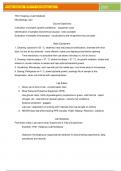Exam (elaborations)
Portage Learning / BIOD 171 microbiology Labs1-9
- Course
- Institution
TK01 Keeping a Lab Notebook Microbiology Lab1 Course Objectives: Cultivation of samples (growth conditions) - equipment used Identification of samples (biochemical assays) - tests available Evaluation of samples (microscopy) - visualizations and recognitions key concepts Basic Equipment: 1. Cl...
[Show more]



